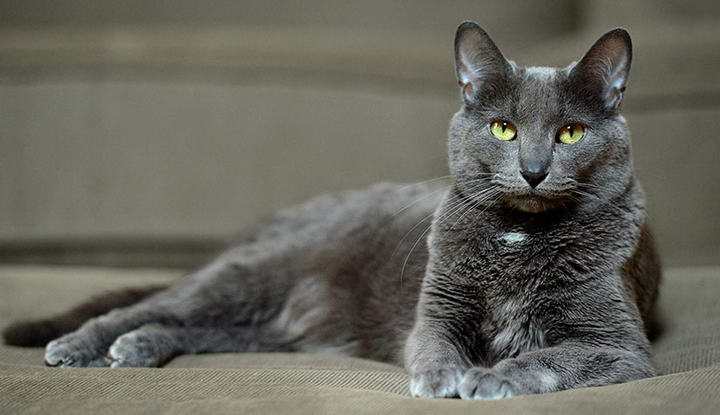Korat cat
IUCN
LCBasic Information
Feature
As a traditional wedding gift in Thailand
Distribution and Habitat
Originated from Thailand
Appearance
The body is half-pony-like, with well-developed muscles. The head is heart-shaped. The ears are large, with rounded tips. The eyes are large and round, crystal green or amber. The nose is short. The limbs are of moderate length. The paws are small and oval. The tail is of moderate length.
The coat color is uniform without stripes, showing silver-gray blue, without any difference in shades or patterns, which is extremely rare. The coat is short, dense, shiny, soft and silky, close to the body surface, and has no inner hair. Because there is almost no undercoat, the Korat cat has poor ability to keep out the cold. Although the Korat cat also sheds its fur seasonally, unlike the fur of other cats, its fur does not become fluffy when it is stroked.
Details
The Korat cat originated in Thailand and was named after its place of origin, the province of Klong Sor, Thailand. It is known locally as "Sisewat", which means auspiciousness. The Korat cat is one of the oldest famous cat breeds that still maintains its pure bloodline.

The handsome silver-blue Korat cat is an ancient breed that lived only in its native Thailand until the late 19th century. It is extremely rare and precious, and is also one of the earliest recorded cat breeds in history. In ancient Thailand, the Korat cat was regarded as a symbol of good luck. A long time ago, the Thai people cherished it and gave it as a precious gift to the people they loved. There is a local custom that if the cat is given to a princess or a high official, it means loyalty and dedication. The Korat cat is also a gift from the Thai royal family to reward meritorious ministers or nobles. Since ancient times, it has been regarded as a "lucky messenger" by Thai people and is highly favored in the upper class. On the day of the bride's wedding, she often gets a pair of Korat cats. Legend has it that the silver tips on the Korat cat's fur symbolize wealth for merchants, and for farmers, it symbolizes colorful clouds that bring rain. They will bring the bride a happy marriage and a happy family. At the same time, the golden green eyes of the Korat cat are also a symbol of thriving rice seedlings in the minds of farmers.
The Korat cat traveled across the ocean and amazed the world when it first appeared at the British cat show, winning applause from the audience. It was introduced to the United States from Thailand in 1959 and was recognized by American cat lovers in 1965. It was not until 10 years later that the United Kingdom recognized this cat.
From the appearance, the Korat cat can be classified as an exotic short-haired cat group because it is small in size, round and stretched, and full of fortitude. Its eyes are large and prominent, bright and blue-green, with sharp eyes, alert and expressive. Purebred Korat cats have been silver-blue since birth. The Korat cat's fur is smooth and seems to be tight on the body. Because there is almost no bottom hair, the Korat cat has poor ability to keep out the cold. Although the Korat cat also sheds its fur seasonally, unlike the fur of other cats, its fur will not become fluffy when it is stroked.
Korat cats are smart and agile, considerate, gentle, loyal to their owners, warm and generous, predictive of what is happening around them, brave and aggressive. Korat cats like to get along with quiet owners, but they have a lonely nature and cannot tolerate the existence of other cats around them. They are slightly neurotic. They are typical apartment cats, extremely bored with noisy environments, and prefer meat. Korat cats have a heavenly voice, and their calls are gentle and low-key, very pleasant. Korat cats are also very intelligent. With a little training, they can learn to pick up toys or walk on their legs, etc. They are perfect companion animals.
Protect wild animals and eliminate game.
Maintaining ecological balance is everyone's responsibility!








